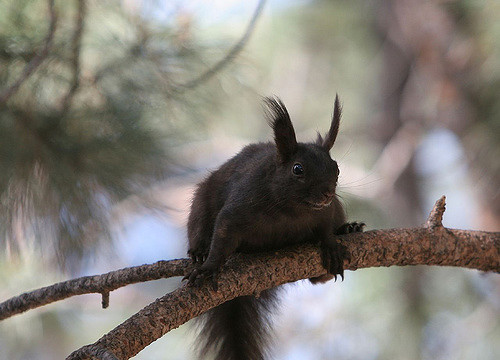
A fleeting glimpse of black caught my eye. I glanced over into the woods, and spotted the tufts of black fur jutting up from the ears, as the Abert’s Squirrel stopped for just a moment to nibble. Clutching a pine cone in its paws, before I could stop to take the photo, it scampered up the Ponderosa Pine tree.
Plentiful Squirrels this Summer
For whatever reason, I’ve been seeing a number of Abert’s Squirrels around our neighborhood the last month. I can remember past summers without even seeing one, but this year, it feels like they are everywhere.
Just the other day, we stood on our deck after barbecuing, and two of them zipped in and around the pine trees just off the deck. I’ve seen this phenomenon of a surge in population of various wildlife before. I’m left to ponder — why?
Right after the 2013 flood, we had a surge in the badger population in Nederland. Our two acres of property literally looked like a giant network of tunnels going hither and yon. Did the flooding cause them to relocate? Were their dens washed away by slides, forcing them to move? Or was it just an aberration that had nothing to do with weather and climate?
A Unique Relationship
With the Abert’s Squirrel, I’m thinking it has to do with Ponderosa Pine. As the Ponderosa Pine goes, so goes the Abert’s Squirrel. These squirrels have a unique, symbiotic relationship with Ponderosa Pine. Therefore, you will only find this dark squirrel where the red-barked trees grow. They prefer a drier climate, so can only be found in the Southern Rockies of Colorado, New Mexico and Arizona, between 5,500 and 8,500 feet.
It’s easy to pick out the Abert’s with its dark, almost black coat and ear tufts. You can often figure out where they’ve been as they leave piles of debris underneath the Ponderosas. They love to chew on the cones and twigs, often nibbling the cone much like an ear of corn.
But in feeding exclusively on this pine, they also help promote its survival. The Ponderosa bark contains a type of fungi that is also eaten by the squirrel. By consuming it, the Abert’s helps spread the spores of the fungi and helps new Ponderosas grow. But it’s not just trees that are helped by this small, but mighty mammals.
As they leave behind their trash from their copious meals, hoofed mammals follow. Deer and elk will nibble on the remains of the twigs and cones left behind.
Look Up, Not Down
This time of year, you may be able to better glimpse this interesting creatures by looking up in the trees. Much like birds, they build nests high up in the pine, and will give birth to pink, hairless babies. Later in the summer, the young will learn how to gather food from their mothers as they get ready for the coming winter.
I love watching the Abert’s, but much like other squirrels, it’s hard to really get a good photo of them. They are extremely active and industrious, so it’s rare for them to stand still for more than just a few seconds.


Love seeing them – fun to watch them chase each other up and down and around. We’ve always had them here for the past 21 years. But badgers? What?